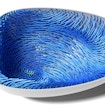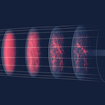Laser-Controlled Novel Superconductors Could Help Pave the Way to Quantum Computers
Controlling the quantum properties of materials is a central challenge in physics as well as an essential step toward using quantum physics for applications such as scalable quantum computers.
One research frontier in this field is the use of strong electromagnetic radiation to push materials out of their normal equilibrium, resulting in the emergence and stabilization of new phases with novel, useful and controllable properties.
In work just published in Nature Physics, a team of theoretical physicists in the United States and Germany has shown that tailored laser pulses can be used to control the properties of chiral topological superconductors.
“This work provides a beautiful example of how simple, tailored laser pulses, widely available in experimental labs, can be used to control and stabilize new quantum phases of matter and induce novel properties that can have impact in the development of quantum technologies,” says study co-author Angel Rubio, distinguished research scientist at the Flatiron Institute’s Center for Computational Quantum Physics (CCQ) in New York City and managing director of the Max Planck Institute for the Structure and Dynamics of Matter in Hamburg, Germany.
Rubio worked on the study along with CCQ research fellows Martin Claassen and Manuel Zingl, Dante Kennes of Freie Universität Berlin, and Michael Sentef of the Max Planck Institute for the Structure and Dynamics of Matter.
Superconductors are materials that can conduct electricity without resistance. Currently, superconductivity only occurs under specific circumstances, for example at very low temperatures. Chiral topological superconductors are a particular class that hosts an elusive particle called a Majorana fermion. This particle can be used to robustly encode quantum bits and perform error-resilient computation. However, controlling and manipulating the materials’ emergent properties poses a significant challenge.
Fundamentally, the chiral topological nature of these materials relies on the rotational and reflection symmetries of the crystal lattice, which maintain a subtle balance between competing superconducting states. The physicists found that a weak pulse can disrupt this balance and induce a dramatic change in the underlying electronic order. This occurs because the pulse selectively breaks these symmetries via choice of polarization.
In particular, the team showed numerically that an appropriately tuned pulse sequence can selectively reverse the ‘handedness’ of a chiral-superconducting region on a very fast timescale (on the order of trillionths of a second). This handedness is an intrinsic topological property of such materials and sets the propagation direction (clockwise or counterclockwise) of Majorana fermions that are induced along its boundary.
An intriguing consequence of their work is the possibility of optically ‘programming’ topologically protected quantum circuits to perform computation on the charging states of single electrons injected into the Majorana boundary modes. Furthermore, the underlying mechanism is robust and relies solely on symmetry, not on the materials’ properties. It could be applied to any material with multicomponent order parameters of the appropriate symmetries.
The physicists predict that topological superconductivity can be detected in standard time-resolved pump-probe experiments where an initial laser pulse alters the superconducting state in the material and a second ‘reads’ these changes after a short delay. This establishes pump-probe experiments as a new experimental tool to reveal the putative chiral topological nature of superconductivity in a wide array of candidate materials such as Sr2RuO4, twisted bilayer graphene, SrPtAs, or UPt3.
The control of chiral topological superconductors opens “new avenues for exciting applications in the hot field of topological quantum computing,” Rubio says. “Moreover, this concept is more general and can be applied to realize new states of matter with tailored topological protected properties. This is a fascinating field with a bright future that will trigger further experimental and theoretical works. Many surprises are waiting to be unraveled in front of us.”


